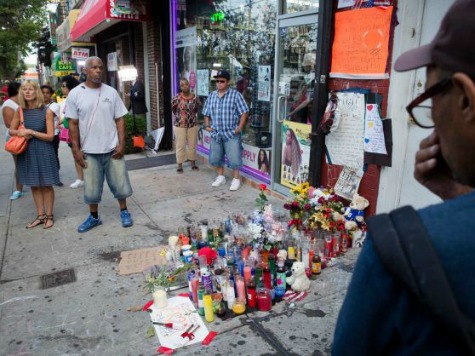Let us stipulate that the death of 43-year-old Eric Garner was horrific and never should never have happened. Given the shocking video evidence of a confrontation with New York City police in which officer Daniel Pantaleo is seen grabbing Garner from behind around the neck, many people on all sides of the political divide feel that a grand jury’s decision not to indict Pantaleo is outrageous. Yet a significant number of questions remain.
1. What happened in the “missing” portion of the video? The video that has been widely circulated has two jump-cuts–one at 0:42 and one at 1:15 in the version published by the New York Daily News. We do not know what information the grand jury reviewed, and the missing video, among other evidence, may provide some indication of why the police felt that Garner had to be restrained forcibly and arrested, rather than let go.
2. Was the maneuver Pantaleo performed actually a “chokehold”? The official autopsy indicates that Garner died from a “choke hold” by Pantaleo. Yet many police experts have said that Pantaleo did not actually apply a chokehold (banned by police procedue). Pantaleo told the grand jury that he used a “takedown” maneuver. And when Garner is telling police, “I can’t breathe,” Pantaleo’s arm is no longer around his neck.
3. Why did police confront Garner in the first place? It has been reported that Garner was targeted by police for selling individual cigarettes, called “loosies,” in violation of a city ordinance. And indeed, that is what Garner seems to be discussing with police in resisting his arrest. But the voice-over on the video comments: “All he did was break up a fight.” We do not know what Garner did, and if was stopped for involvement in that fight.
4. Who called the police? The regulation against loosies was imposed by Mayor Michael Bloomberg in an effort to crack down on smoking, a legal (if costly) habit. As the Times noted in 2011, the rule resulted in routine, almost familiar arrests of vendors on the street. In the Garner case, the New York Times suggests that police responded to “a complaint voiced by local business owners.” Who called the police that day, and why?
5. Was Pantaleo’s conduct “reckless”? Sean Davis is certain that Pantaleo is guilty of second-degree manslaughter, which requires “reckless” behavior, i.e. a depraved disregard for human life. Notably, Pantaleo chose not to use his gun. Even assuming Pantaleo used a chokehold, what evidence is there that he could have reasonably foreseen that doing so could lead to Garner’s death? Did he even intend to apply a chokehold?
The questions above do not justify Garner’s death, but may raise reasonable doubt about Pantaleo’s guilt. That does not mean that he should not have been indicted: the standard of proof for “probable cause” is much lower than the standard for conviction. Perhaps these are questions a jury should have considered following an indictment and prosecution. And the available evidence seems enough to establish civil liability–i.e. that Pantaleo was more likely than not to have caused Garner’s death.
Still, there is enough that is still unknown about the death of Eric Garner–even with the chilling video–that ought to be acknowledged. And it is worth pointing out that no evidence exists to support the accusation that Garner was targeted out of racism, as President Barack Obama, Attorney General Eric Holder, and New York City Mayor Bill de Blasio have all suggested.
Senior Editor-at-Large Joel B. Pollak edits Breitbart California and is the author of the new ebook, Wacko Birds: The Fall (and Rise) of the Tea Party, available for Amazon Kindle.
Follow Joel on Twitter: @joelpollak

COMMENTS
Please let us know if you're having issues with commenting.